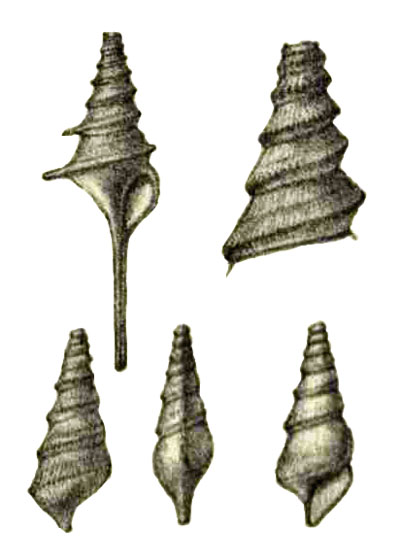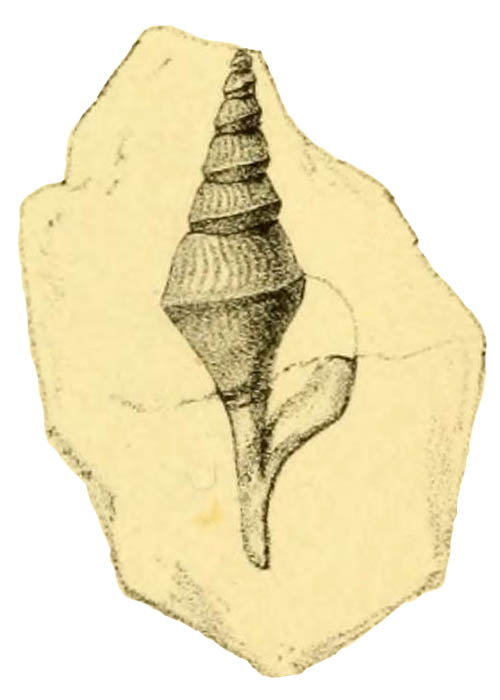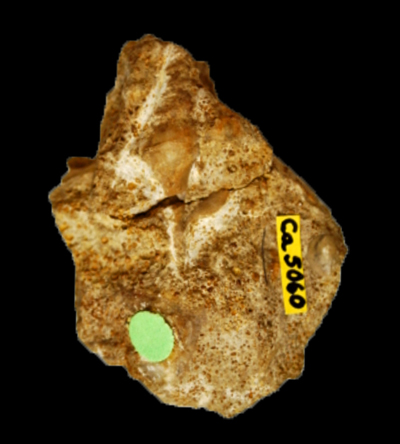|
edit SideBar
|
Species / Spiniloma Trinitatis
Stromboidea
Original Description of Alaria trinitatis by Tawney, 1874, p. 20:
- "The materials for this species are very imperfect, but it cannot be identified with any previously described. The shell is very acute; whorls angular, about 8 in number; the keel is very near the inferior edge of the whorl, and not parallel to the suture; this is the most marked feature of the shell - it is caused by a spine apparently on the keel at the same place, in successive whorls, so that there is sometimes an appearance of a ridge all down the shell. On the last whorl of one specimen are seen two spines, one below the other, the upper one stronger. The surface is ornamented with fine longitudinal lines, and somewhat stronger wavy transverse ones. It is much more acute than Alaria longispina, Desl. sp., and the position of the keel would distinguish it. There are eight specimens in the Museum.
Locus typicus: Dundry, Somerset County, South West Region, England
Stratum typicum: Inferior Oolite, middle Jurassic
Alaria trinitatis Tawney, 1874, pl. 1, fig. 6
Alaria trinitatis Tawney, 1874; Inferior Oolite, middle Jurassic; Dundry, Somerset County, UK; Holotype; Coll. Bristol Musums CA 5060; Copyright Bristol Museums, UK
History and Synonymy
1888
Hudleston, 1888, p. 103:
- "Mr. Tawney, in describing his species, admitted that the materials were very imperfect; and this we can easily believe, since it would be difficult to conjecture from the figure given in the 'Dundry Gasteropoda,' that the specimen was a Spinigera. However, there was enough to distinguish it from "Alaria" longispina, Desl. Sp. trinitatis is probably closely related to Rostellaria spinosa, Münster. At any rate the species from the Jura-kalk of Pappenheim is evidently a Spinigera, and resembles this species rather than Sp. longispina, Desl."
- "Description : Length [In all cases the canal is excluded.] . . . . .18 mm. Ratio of minor to major axis of width . . 53 : 100. Shell elongate, fusiform. Whorls of spire extremely flattened, body-whorl less so; apical whorls smooth and tumid ; next whorl has a median costated keel (fig. 3 b); then comes a whorl with a keel nearly median and finely crenulated; each of these whorls presents a fine basal rim just above the suture. The four or five remaining whorls, including the body-whorl, have the keel almost at the anterior extremity; traces of the fine crenulation are seen on the keels of the two higher whorls, but this is almost obliterated on the penultimate and body-whorl. In the four or five last whorls there are two fine spiral lines above the keel, and one below; these are decussated by numerous fine radial lines, often indistinct. The four or five last whorls also develop a continuous chain of bilateral varices (fig. 3 e), each of which sends out a spine on crossing the keel (not always visible). Aperture subovate, elongate; canal very long and straight. Without wing, except so far as the antero-lateral spine, originating in the varix, and not in the outer lip, represents one."
- "Relations and Distribution. — This species is extremely variable, especially as to the position of the keel in the anterior whorls. Occasionally the body-whorl is more angular, and in such cases specimens are not always to be distinguished from Sp. didactyla. Indeed, it is possible that Sp. trinitatis represents an incomplete stage of that very bizarre form. Somewhat rare in the Sowerbyi-bed of Bradford Abbas, and quoted also from Dundry."
 Spinigera trinitatis in Hudleston, 1888, pl. 3, fig. 3 a, b, c, d, e
References
|



